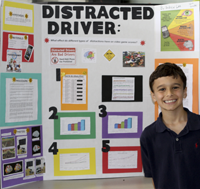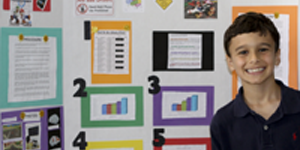Success Story: A Crash Course Science Project
"Distracted driving" accounts for a staggering number of accidents. A fourth grade student in LA put distracted drivers to the test with a familiar video game.

Andrew Lee, pictured above, put questions about cell phone use and driving to the test using a popular driving-based video game. "I collected data that could save lives," he says.
Science Buddies Project Ideas in Video & Computer Games assist students in exploring science and engineering questions both by using video games and by designing their own. Read about other student science successes in the Science Buddies in Action area.
Attention to the Road
Public service announcements warn about the dangers of texting while driving, and the Governors Highway Safety Association® notes that as of July 2012, 39 states have laws against texting while driving. Some states have additional laws regulating other kinds of cellphone usage while driving. California law, for instance, mandates hands-free cellphone use (although even this is not allowed for certain categories of drivers). With an estimated 8000 crashes every day being attributed to what is commonly referred to as "distracted driving," and statistics suggesting that hands-on cellphone use while driving quadruples the chance of an accident, the data seems clear: cellular multitasking while driving is dangerous.
Singling in on texting, Parkview Trauma Center's Dont Text and Drive campaign warns that texting while driving makes you 23 times more likely to have a crash. Alarmingly, statistics even suggest that the risk of accident when texting while driving is even higher than the high rate of accident associated with driving under the influence of alcohol. While accident and fatality statistics related to cell phone usage paint a grim picture, increasingly cellphone-connected lifestyles have turned car-time, for some, into check-in time for voice mail, email, and other cell communications.
Are all forms of phone-based distraction equal? Does using a headset for hands-free talking lessen the risk of an accident? What about other in-car activities that may also compromise a driver's full attention to the road? Have you ever driven by someone who is reading or putting on lipstick while driving? Are all forms of while-driving activities comparable in terms of distraction and risk?
Science Buddies in Action: A Video Game Simulation
As a fourth grade student in Los Angeles, Andrew Lee decided to put "distracted driving" to the test, not on the road but with video games. For his first science fair project, Andrew chose the "Distracted Driver: Do Distractions Affect Driving Video Game Scores?" project because he is interested in how the brain works and he thought it "would be fun to do a science experiment involving video games."
After doing his background research, Andrew used the Science Buddies Project Idea to help design an experiment that would let him observe and evaluate different forms of distraction and how they influence a driver's ability to drive safely within a driving-style video game. Following the steps of the scientific method, Andrew came up with his main hypothesis. "My hypothesis was that driving video game scores become lower (worse) when the driver is distracted," he says. A second hypothesis for his project targeted which kind of distraction might result in the worst scores.
Distracted Drivers
Using Mario Kart for the Wii and the wheel attachment for the remote control to better simulate real-world driving, Andrew observed test subjects playing the game with different levels of distraction present, including no distraction, talking on a cell phone, and emailing using a cell phone.
The data Andrew collected as a result of his testing showed that, while some people handle distractions better than others, and not all distractions are equal, "distraction" can be detrimental for drivers. Andrew observed that players scored highest and took the least amount of time to navigate a course when there were no distractions present. "Every driver got a better score and had less crashes when there were no distractions while they were driving," reports Andrew, reasoning that the players were able to concentrate more fully on the game. On the flip side, every driver performed worst when engaged in one of his "distraction" activities while playing the driving game.
In the end, Andrew proved his hypothesis and observed, firsthand, the ways in which sources of distraction may impact, split, or change a person's ability to focus on the task at hand—all of which may have dangerous implications for drivers at the wheel. "When a driver is holding something (like a phone) their driving gets worse," says Andrew.
Andrew's game-based simulation of distracted driving was low-risk but underscored the potential for similar real-world danger. "When you are playing a driving video game, the worst thing that can happen is that your score is low or you bump another car," notes Andrew. "In real driving, someone could get really injured or worse. I hope everyone learns from this experiment and drives safely in the future."
On the Road
For Andrew, who says he wants to be an inventor someday, his first science fair was a powerful first step. "I collected data that could save lives," says Andrew. But he also had a lot of fun with his science fair project. "It was a great experience, and it was my favorite project of the whole year. I can't wait to participate again next year."
Learn more about the benefits of science fair projects in our five-part Why Do Science Projects and Science Fairs? blog series.
Categories:
You Might Also Enjoy These Related Posts:
- Making Recycling Sorting Machines—STEM Success
- Mini Trebuchets and a NM MESA Challenge
- Helping Students Build Coding Skills with Drones and Self-Driving Cars
- Middle School Student Codes to Improve Life with Visual Impairment
- Student Science Project - Designing and Coding a Video Game to Help People with Alzheimer's
- Teacher Combines Computer Science and Engineering Design for Middle School Students - STEM Success Story
- A Mirror Maze Success Story
- Paper Roller Coasters and Energy Transformation: STEM Teacher Success Story










